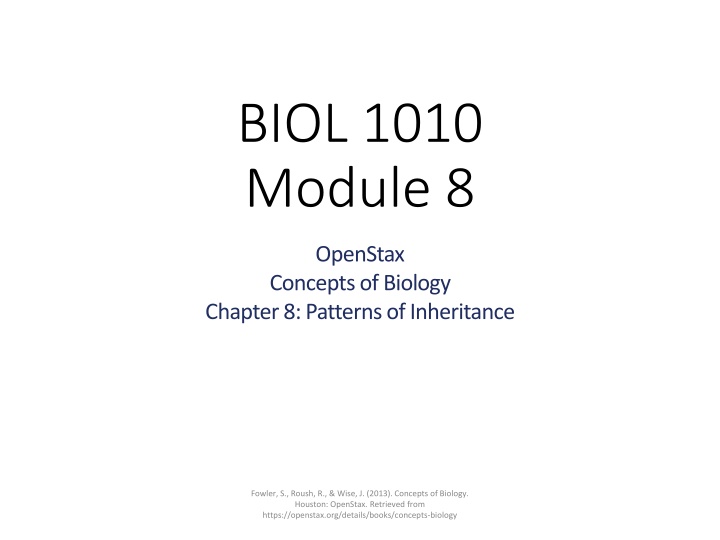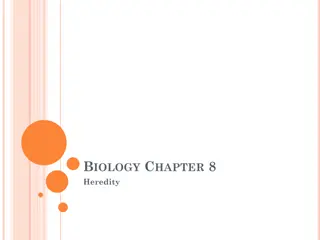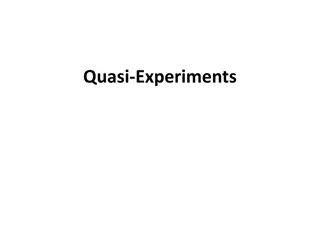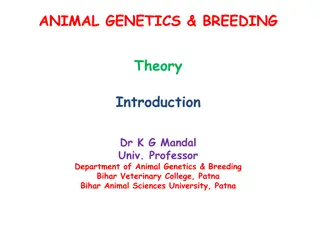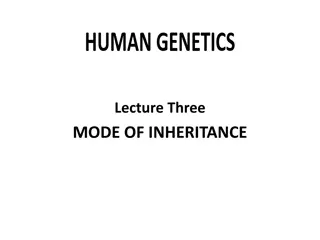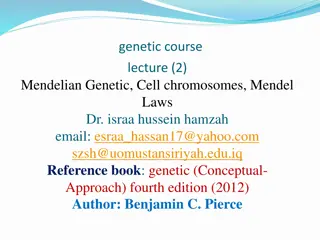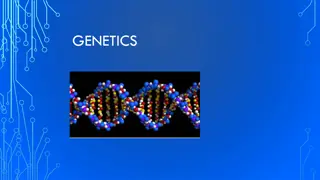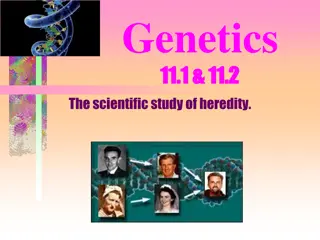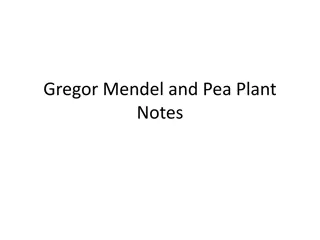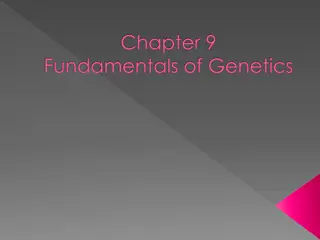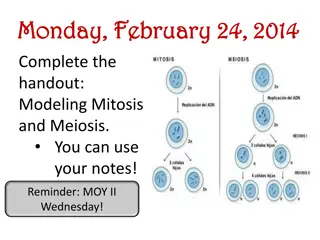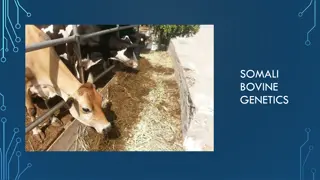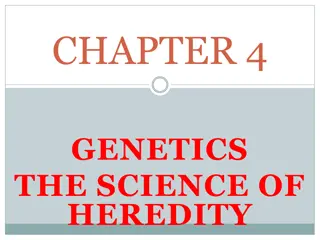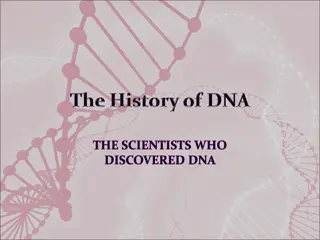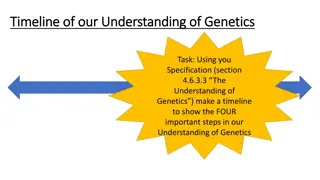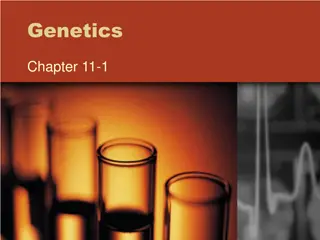Mendel's Experiments in Genetics
Mendel's groundbreaking experiments with pea plants led to the discovery of inheritance patterns and the distinction between continuous and discontinuous variation. His work set the foundation for the study of genetics, uncovering the secrets of heredity that shape living organisms.
Download Presentation

Please find below an Image/Link to download the presentation.
The content on the website is provided AS IS for your information and personal use only. It may not be sold, licensed, or shared on other websites without obtaining consent from the author.If you encounter any issues during the download, it is possible that the publisher has removed the file from their server.
You are allowed to download the files provided on this website for personal or commercial use, subject to the condition that they are used lawfully. All files are the property of their respective owners.
The content on the website is provided AS IS for your information and personal use only. It may not be sold, licensed, or shared on other websites without obtaining consent from the author.
E N D
Presentation Transcript
BIOL 1010 Module 8 OpenStax Concepts of Biology Chapter 8: Patterns of Inheritance Fowler, S., Roush, R., & Wise, J. (2013). Concepts of Biology. Houston: OpenStax. Retrieved from https://openstax.org/details/books/concepts-biology
Figure 8.1 8.1 Mendel s experiments Learning Outcomes: Explain the scientific reasons for the success of Mendel s experimental work Describe the expected outcomes of monohybrid crosses involving dominant and recessive alleles Experimenting with thousands of garden peas, Mendel uncovered the fundamentals of genetics. (credit: modification of work by Jerry Kirkhart) Fowler, S., Roush, R., & Wise, J. (2013). Concepts of Biology. Houston: OpenStax. Retrieved from https://openstax.org/details/books/concepts-biology
Figure 8.2 Johann Gregor Mendel (1822-1884) Austrian monk Taught physics, botany, and natural science at the secondary and university levels 1856 Began his work on heredity Used pea plants to study inheritance patterns Model system - a species or biological system used to study a specific biological phenomenon to gain understanding that will be applied to other species Published in 1866 Johann Gregor Mendel set the framework for the study of genetics. Fowler, S., Roush, R., & Wise, J. (2013). Concepts of Biology. Houston: OpenStax. Retrieved from https://openstax.org/details/books/concepts-biology
8.1 Mendels experiments Mendel s work went unnoticed due to the contemporary hypothesis that inheritance was a blending of parental traits giving an intermediate physical appearance in offspring due to continuous variation Continuous variation - a variation in a characteristic in which individuals show a range of traits with small differences between them Mendel worked with traits that exhibit discontinuous variation Discontinuous variation - a variation in a characteristic in which individuals show two, or a few, traits with large differences between them Allowed Mendel to easily distinguish between blended hypothesis and inheritance of distinct traits Fowler, S., Roush, R., & Wise, J. (2013). Concepts of Biology. Houston: OpenStax. Retrieved from https://openstax.org/details/books/concepts-biology
8.1 Mendels experiments Advantages of pea plants Self fertilizing, allowing extablishment of true-breeding lines of plants Grow to maturity in 1 season Large quantities can be cultivated simultaneously Mendel crossed true-breeding plants by manually pollinating flowers to create hybrids Hybridization - the process of mating two individuals that differ, with the goal of achieving a certain characteristic in their offspring Fowler, S., Roush, R., & Wise, J. (2013). Concepts of Biology. Houston: OpenStax. Retrieved from https://openstax.org/details/books/concepts-biology
Mendels experiments Mendel s Pea Plants P = parental generation F1 = first filial generation; offspring resulting from crossing P generation F2 = second filial generation; offspring resulting from self- pollination of F1 generation Mendel s process for performing crosses included examining flower color. Fowler, S., Roush, R., & Wise, J. (2013). Concepts of Biology. Houston: OpenStax. Retrieved from https://openstax.org/details/books/concepts-biology
8.1 Mendels experiments Mendel studied 7 traits Trait - a variation in an inherited characteristic Examined: Plant height Seed texture Seed color Flower color Flower position Pea-pod size Pea-pod color Generated large numbers of plants to give results statistical power Confirmed true-breeding by allowing self pollination for several generations before performing crosses Fowler, S., Roush, R., & Wise, J. (2013). Concepts of Biology. Houston: OpenStax. Retrieved from https://openstax.org/details/books/concepts-biology
Figure 8.4 Mendel identified seven pea plant characteristics. Fowler, S., Roush, R., & Wise, J. (2013). Concepts of Biology. Houston: OpenStax. Retrieved from https://openstax.org/details/books/concepts-biology
8.1 Mendels experiments Mendel was able to characterize his traits based on his results Dominant - describes a trait that masks the expression of another trait when both versions of the gene are present in an individual Recessive - describes a trait whose expression is masked by another trait when the alleles for both traits are present in an individual Demonstrated that traits were not blended Hypothesized that this was due to plants inheriting 2 copies of trait, or factors that govern trait A plant with a dominant trait could have 2 copies of dominant factor, on one dominant copy and one recessive copy A plant with a recessive trait could only have 2 copies of recessive factor Fowler, S., Roush, R., & Wise, J. (2013). Concepts of Biology. Houston: OpenStax. Retrieved from https://openstax.org/details/books/concepts-biology
8.2 Laws of inheritance Learning Outcomes: Explain the relationship between genotypes and phenotypes in dominant and recessive gene systems Use a Punnett square to calculate the expected proportions of genotypes and phenotypes in a monohybrid cross Explain Mendel s law of segregation and independent assortment in terms of genetics and the events of meiosis Explain the purpose and methods of a test cross Fowler, S., Roush, R., & Wise, J. (2013). Concepts of Biology. Houston: OpenStax. Retrieved from https://openstax.org/details/books/concepts-biology
8.2 Laws of inheritance In a diploid organism, for traits controlled by a single gene, there are two copies of each gene Allele - one of two or more variants of a gene that determines a particular trait for a characteristic Phenotype - the observable traits expressed by an organism Genotype - the underlying genetic makeup, consisting of both physically visible and non-expressed alleles, of an organism One copy of gene is dominant over the other Example: seed color in P generation, one parent plant had yellow (dominant) and one had green (recessive) In the F1, all had one of each allele, but seed were all yellow b/c it is the dominant allele Crossing F1 revealed that they had 2 copies, because the recessive reappears Fowler, S., Roush, R., & Wise, J. (2013). Concepts of Biology. Houston: OpenStax. Retrieved from https://openstax.org/details/books/concepts-biology
8.2 Laws of inheritance P generation is homozygous for each trait Homozygous - having two identical alleles for a given gene on the homologous chromosomes Heterozygous - having two different alleles for a given gene on the homologous chromosomes Dominant allele is represented as a capital letter, recessive as a lower-case letter Law of Dominance - in a heterozygote, one trait will conceal the presence of another trait for the same characteristic Fowler, S., Roush, R., & Wise, J. (2013). Concepts of Biology. Houston: OpenStax. Retrieved from https://openstax.org/details/books/concepts-biology
Figure 8.5 Phenotypes are physical expressions of traits that are transmitted by alleles. Capital letters represent dominant alleles and lowercase letters represent recessive alleles. The phenotypic ratios are the ratios of visible characteristics. The genotypic ratios are the ratios of gene combinations in the offspring, and these are not always distinguishable in the phenotypes. Fowler, S., Roush, R., & Wise, J. (2013). Concepts of Biology. Houston: OpenStax. Retrieved from https://openstax.org/details/books/concepts-biology
8.2 Laws of inheritance Table 8.1 Correspondence between Genotype and Phenotype for a Dominant-Recessive Characteristic. Homozygous Heterozygous Homozygous Genotype YY Yy yy Phenotype Yellow Yellow Green Fowler, S., Roush, R., & Wise, J. (2013). Concepts of Biology. Houston: OpenStax. Retrieved from https://openstax.org/details/books/concepts-biology
8.2 Laws of inheritance Monohybrid cross - the result of a cross between two true- breeding parents that express different traits for only one characteristic Mendel s crosses involved 1 trait governed by Law of Dominance P generation were homozygous, F1 were heterozygous, and F2 were homozygous dominant, heterozygous, and homozygous recessive with a 1:2:1 genotypic ratio and a 3:1 phenotypic ratio of dominant:recessive Fowler, S., Roush, R., & Wise, J. (2013). Concepts of Biology. Houston: OpenStax. Retrieved from https://openstax.org/details/books/concepts-biology
8.2 Laws of inheritance Punnet square - a visual representation of a cross between two individuals in which the gametes of each individual are denoted along the top and side of a grid, respectively, and the possible zygotic genotypes are recombined at each box in the grid Example: Cross two organisms that are heterozygous for purple flowers (Pp) P Other parent p One parent P PP Pp p Pp pp Fowler, S., Roush, R., & Wise, J. (2013). Concepts of Biology. Houston: OpenStax. Retrieved from https://openstax.org/details/books/concepts-biology
Figure 8.9 This Punnett square shows the cross between plants with yellow seeds and green seeds. The cross between the true- breeding P plants produces F1 heterozygotes that can be self-fertilized. The self-cross of the F1 generation can be analyzed with a Punnett square to predict the genotypes of the F2 generation. Given an inheritance pattern of dominant recessive, the genotypic and phenotypic ratios can then be determined. Fowler, S., Roush, R., & Wise, J. (2013). Concepts of Biology. Houston: OpenStax. Retrieved from https://openstax.org/details/books/concepts-biology
Figure 8.6 The allele for albinism, expressed here in humans, is recessive. Both of this child s parents carried the recessive allele. Fowler, S., Roush, R., & Wise, J. (2013). Concepts of Biology. Houston: OpenStax. Retrieved from https://openstax.org/details/books/concepts-biology
Figure 8.7 The first division in meiosis is shown. Law of Segregation - paired unit factors (i.e., genes) segregate equally into gametes such that offspring have an equal likelihood of inheriting any combination of factors Fowler, S., Roush, R., & Wise, J. (2013). Concepts of Biology. Houston: OpenStax. Retrieved from https://openstax.org/details/books/concepts-biology
Figure 8.8 To determine whether a parent is homozygous or heterozygous, perform a test cross Test cross - a cross between a dominant expressing individual with an unknown genotype and a homozygous recessive individual; the offspring phenotypes indicate whether the unknown parent is heterozygous or homozygous for the dominant trait A test cross can be performed to determine whether an organism expressing a dominant trait is a homozygote or a heterozygote. Fowler, S., Roush, R., & Wise, J. (2013). Concepts of Biology. Houston: OpenStax. Retrieved from https://openstax.org/details/books/concepts-biology
8.2 Laws of inheritance Law of Independent Assortment - genes do not influence each other with regard to sorting of alleles into gametes; every possible combination of alleles is equally likely to occur Dihybrid - the result of a cross between two true-breeding parents that express different traits for two characteristics Inheritance of one allele doesn t affect inheritance of another allele Fowler, S., Roush, R., & Wise, J. (2013). Concepts of Biology. Houston: OpenStax. Retrieved from https://openstax.org/details/books/concepts-biology
Figure 8.10 A dihybrid cross in pea plants involves the genes for seed color and texture. The P cross produces F1 offspring that are all heterozygous for both characteristics. The resulting 9:3:3:1 F2 phenotypic ratio is obtained using a Punnett square. Fowler, S., Roush, R., & Wise, J. (2013). Concepts of Biology. Houston: OpenStax. Retrieved from https://openstax.org/details/books/concepts-biology
Figure 8.11 The random segregation into daughter nuclei that happens during the first division in meiosis can lead to a variety of possible genetic arrangements. Fowler, S., Roush, R., & Wise, J. (2013). Concepts of Biology. Houston: OpenStax. Retrieved from https://openstax.org/details/books/concepts-biology
8.3 Extensions of the Laws of Inheritance Learning Outcomes Identify non-Mendelian inheritance patterns such as incomplete dominance, codominance, multiple alleles, and sex linkage from the results of crosses Explain the effect of linkage and recombination on gamete genotypes Explain the phenotypic outcomes of epistatic effects among genes Fowler, S., Roush, R., & Wise, J. (2013). Concepts of Biology. Houston: OpenStax. Retrieved from https://openstax.org/details/books/concepts-biology
8.3 Extensions of the Laws of Inheritance Not all traits are governed by a recessive/dominant allele pair Mendel s work suggested that: 1. Two types of units or alleles exist for every gene 2. Alleles maintain integrity in each generation 3. In the presence of the dominant allele, the recessive allele is hidden, with no contribution to the phenotype Heterozygotes are sometimes called carriers because they carry the unexpressed recessive allele Fowler, S., Roush, R., & Wise, J. (2013). Concepts of Biology. Houston: OpenStax. Retrieved from https://openstax.org/details/books/concepts-biology
8.3 Extensions of the Laws of Inheritance Incomplete dominance - in a heterozygote, expression of two contrasting alleles such that the individual displays an intermediate phenotype Heterozygote has a phenotype where both alleles are expressed Genotypic ratio and phenotypic ratio are the same Example: snapdragons red flowers (CRCR) are incompletely dominant to white flowers (CWCW) Heterozygote (CRCW) is pink Genotypic and phenotypic ratio from cross of 2 heterozygotes is 1:2:1 CRCR: CRCW: CWCW or red:pink:white Fowler, S., Roush, R., & Wise, J. (2013). Concepts of Biology. Houston: OpenStax. Retrieved from https://openstax.org/details/books/concepts-biology
Figure 8.12 These pink flowers of a heterozygote snapdragon result from incomplete dominance. (credit: storebukkebruse /Flickr) Fowler, S., Roush, R., & Wise, J. (2013). Concepts of Biology. Houston: OpenStax. Retrieved from https://openstax.org/details/books/concepts-biology
8.3 Extensions of the Laws of Inheritance Codominance - in a heterozygote, complete and simultaneous expression of both alleles for the same characteristic Both alleles are expressed in the heterozygote Example: human blood group types Fowler, S., Roush, R., & Wise, J. (2013). Concepts of Biology. Houston: OpenStax. Retrieved from https://openstax.org/details/books/concepts-biology
Figure 8.13 This Punnet square shows an AB/AB blood type cross Fowler, S., Roush, R., & Wise, J. (2013). Concepts of Biology. Houston: OpenStax. Retrieved from https://openstax.org/details/books/concepts-biology
8.3 Extensions of the Laws of Inheritance Multiple alleles can have more than 2 variants of a gene in a population Wild type - the most commonly occurring genotype or phenotype for a given characteristic found in a population Example: ABO blood types 3 alleles in the population IA = A antigen on red blood cells IB = B antigen on red blood cells i = no antigen - recessive Codominant Fowler, S., Roush, R., & Wise, J. (2013). Concepts of Biology. Houston: OpenStax. Retrieved from https://openstax.org/details/books/concepts-biology
Figure 8.14 Inheritance of the ABO blood system in humans is shown. Fowler, S., Roush, R., & Wise, J. (2013). Concepts of Biology. Houston: OpenStax. Retrieved from https://openstax.org/details/books/concepts-biology .
8.3 Extensions of the Laws of Inheritance Sex-linked traits alleles found on X-chromosome X-linked - a gene present on the X chromosome, but not the Y chromosome Women are XX, so 2 alleles for each trait Men are XY, so only have 1 allele for each trait Hemizygous - the presence of only one allele for a characteristic, as in X-linkage; hemizygosity makes descriptions of dominance and recessiveness irrelevant Fowler, S., Roush, R., & Wise, J. (2013). Concepts of Biology. Houston: OpenStax. Retrieved from https://openstax.org/details/books/concepts-biology
Figure 8.15 In Drosophila, the gene for eye color is located on the X chromosome. Red eye color is wild- type and is dominant to white eye color. Fowler, S., Roush, R., & Wise, J. (2013). Concepts of Biology. Houston: OpenStax. Retrieved from https://openstax.org/details/books/concepts-biology
Figure 8.16 Crosses involving sex-linked traits often give rise to different phenotypes for the different sexes of offspring, as is the case for this cross involving red and white eye color in Drosophila. In the diagram, w is the white-eye mutant allele and W is the wild-type, red-eye allele. Fowler, S., Roush, R., & Wise, J. (2013). Concepts of Biology. Houston: OpenStax. Retrieved from https://openstax.org/details/books/concepts-biology
8.3 Extensions of the Laws of Inheritance Linkage - a phenomenon in which alleles that are located in close proximity to each other on the same chromosome are more likely to be inherited together Not all alleles are inherited independently Crossing over can disrupt linkage, but genes that are physically close together on a chromosome tend to be inherited together Recombination - the process during meiosis in which homologous chromosomes exchange linear segments of genetic material, thereby dramatically increasing genetic variation in the offspring and separating linked genes Fowler, S., Roush, R., & Wise, J. (2013). Concepts of Biology. Houston: OpenStax. Retrieved from https://openstax.org/details/books/concepts-biology
Figure 8.17 The process of crossover, or recombination, occurs when two homologous chromosomes align and exchange a segment of genetic material. Fowler, S., Roush, R., & Wise, J. (2013). Concepts of Biology. Houston: OpenStax. Retrieved from https://openstax.org/details/books/concepts-biology
8.3 Extensions of the Laws of Inheritance Most physical characteristics are controlled by multipe genes Example: eye color 8 genes involved Many may act sequentially, or function in a complementary or synergistic fashion Can also oppose one another to cancel out a given effect Epistasis - an interaction between genes such that one gene masks or interferes with the expression of another Example pigmentation in mice WT (agouti, AA) is dominant to solid color (aa) Gene C, when homozygous recessive (cc) negates A, so mice are albino Fowler, S., Roush, R., & Wise, J. (2013). Concepts of Biology. Houston: OpenStax. Retrieved from https://openstax.org/details/books/concepts-biology
Figure 8.18 Aacc, Aacc, and aacc are all albino as well Crossing AaCc to AaCc gives 9 agouti, 3 black, 4 albino C is epistatic to A In this example of epistasis, one gene (C) masks the expression of another (A)for coat color. When the C allele is present, coat color is expressed; when it is absent (cc), no coat color is expressed. Coat color depends on the A gene, which shows dominance, with the recessive homozygote showing a different phenotype than the heterozygote or dominant homozygote. Fowler, S., Roush, R., & Wise, J. (2013). Concepts of Biology. Houston: OpenStax. Retrieved from https://openstax.org/details/books/concepts-biology
8.3 Extensions of the Laws of Inheritance Historical Perspective https://en.wikipedia.org/wiki/Gregor_Mendel Critical Thinking - Could an individual with blood type O (genotype ii) be a legitimate child of parents in which one parent had blood type A and the other parent had blood type B? Fowler, S., Roush, R., & Wise, J. (2013). Concepts of Biology. Houston: OpenStax. Retrieved from https://openstax.org/details/books/concepts-biology
